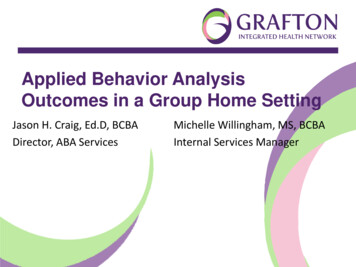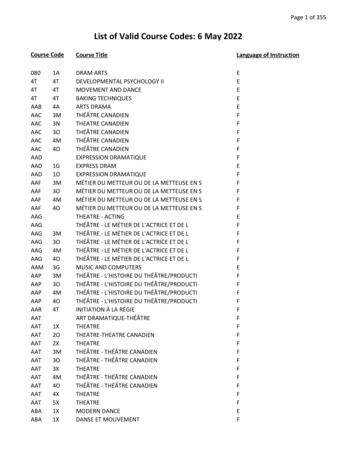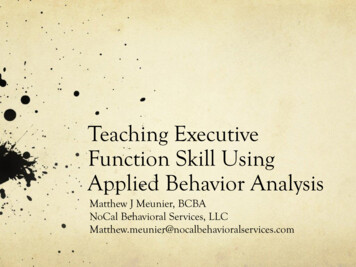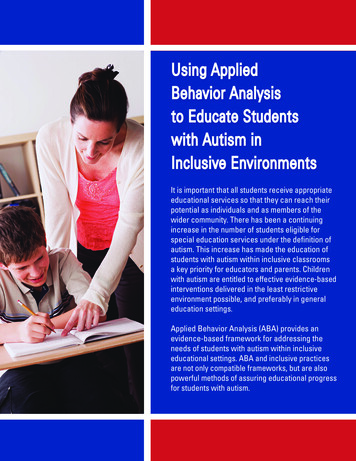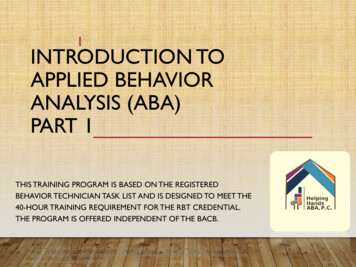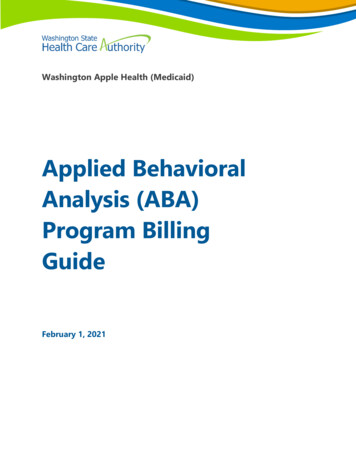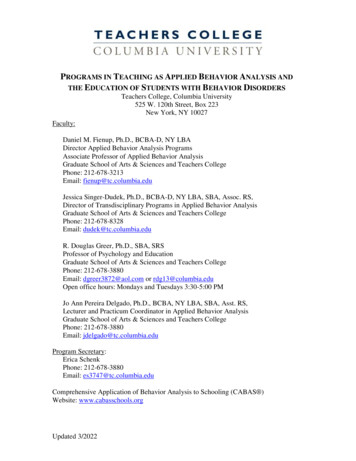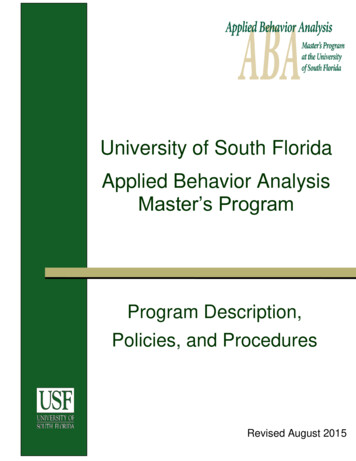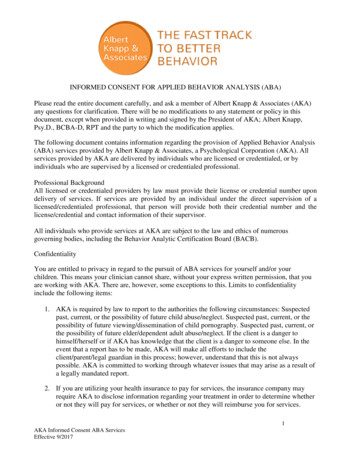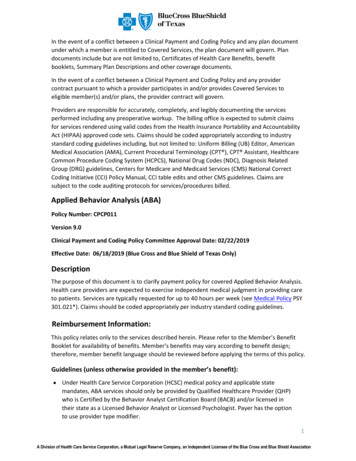
Transcription
Is Applied Behavior Analysis (ABA) and Early Intensive Behavioral Intervention (EIBI)an Effective Treatment for Autism?A Cumulative History of Impartial Independent ReviewsEric V. Larsson, PhD, LP, BCBA-D (2013)Applied Behavior Analysis (ABA) and Early Intensive Behavioral Intervention (EIBI) for Autism are quitepossibly the best examples of evidence-based behavioral health care. Impartial independent reviewpanels consistently agree that ABA and EIBI treatments for autism are effective, and that the extensivebody of research meets high standards of scientific evidence. These reviews also report that ABA and EIBIsignificantly improves the net health outcome in Autism in substantial and far-ranging ways.What is striking about the independent reviews of EIBI and ABA for autism is that the more careful thescrutiny, the more emphatic are the conclusions. For example, the New York, the Maine, and the USAHRQ commissions embarked upon yearlong independent reviews of the scientific support of ALLpossible interventions for autism. Each panel stringently applied scientific standards of proof to allinterventions and found that ABA-based therapies alone, of all possible treatments for children withautism, had been proven effective.As a result, the practice of ABA and EIBI have become part of the mainstream community standard ofcare. The conclusions from many years of independent review are quoted below in chronological order.In 1987, researchers at the University of North Carolina reviewed the early intervention literature toidentify the best practices at the time. They wrote:“Lovaas's (1980, 1982) experimental design included both an intensive treatment group thatreceived 40 hours or more of treatment per week and a less intensive treatment group thatreceived 10 hours of treatment per week. In other respects the nature of intervention was thesame for all children. As summarized in Table 4, the intensive application of this approachresulted in substantial improvement for about half the autistic children. They attained IQs, schoolplacements, and social-emotional ratings not different from normal peers. Children receiving aless intensive version of this approach did not, in any of 19 cases, achieve such gains.”Simeonsson, R.J., Olley, J.G., & Rosenthal, S.L. (1987). Early intervention for children withautism. In M.J. Guralnick & F.C. Bennett (Eds.) The effectiveness of early intervention for atrisk and handicapped children. (pp. 275-296). Orlando FL: Academic Press.In 1994, Bernard Rimland wrote in the Autism Research Review International concerning such results:“we are beginning to hear increasingly about recovery. The matter deserves our close attention.Reports of recovery, partial recovery, or near-recovery, come from several sources.”Rimland, B. (1994). Recovery from autism is possible. Autism Research Review International, 8, 3.(2013) Eric V. Larsson, PhD, LP, BCBA-D
Is EIBI and ABA Sufficiently Evidence-Based to be Medically Necessary Treatment?Page 2In the first Handbook of Autism and Pervasive Developmental Disorders, the researchers wrote:“During the past 10 years, behavioral interventions have become the predominant treatmentapproach for promoting the social, adaptive, and behavioral functioning of children and adultswith autism. The sophistication of these strategies has increased substantially, reflectingadvancements in technique and refinements in behavioral assessment.”Bregman, J.D. & Gerdtz, J. (1997). Behavioral Interventions. In D.J. Cohen & F.R. Volkmar,(Eds.), Handbook of Autism and Pervasive Developmental Disorders (pp. 606-630). NewYork: Wiley.The Autism Society of America, in their informational paper on ABA approaches, stated:“Properly designed and executed ABA programs contain many if not all of the components ofeffective treatment approaches found to be most successful in treating children with autism Research and anecdotal evidence indicate that ABA programs produce comprehensive and lastingimprovements in many important skill areas.”Autism Society of America (1998) Intensive Behavioral Intervention. Informational handoutdownloaded from www.autism-society.orgIn 1998, Division 53 of the American Psychological Association (the Society for Clinical Childand Adolescent Psychology) conducted a Task Force on Empirically Supported Child Psychotherapy.For autism, they found:“The literature on effective focal treatments in autism is plentiful and published in a variety ofjournals, in the fields of developmental disabilities, applied behavior analysis, and disciplinespecific journals. These studies generally consist of single-subject multiple-baseline designs orsmall sample treatment designs. Behavioral treatment approaches are particularly wellrepresented in this body of literature and have been amply demonstrated to be effective inreducing symptom frequency and severity as well as in increasing the development of adaptiveskills.” (p. 168).Rogers, S.J. (1998) Empirically supported comprehensive treatments for young children withautism. Journal of Clinical Child Psychology, 27, 168-179.In 1999, the US Surgeon General issued a lengthy report on the Mental Health in America. In thesection on autism, he concluded:“Thirty years of research demonstrated the efficacy of applied behavioral methods in reducinginappropriate behavior and in increasing communication, learning, and appropriate socialbehavior.”“A well-designed study of a psychosocial intervention was carried out by Lovaas and colleagues.Nineteen children with autism were treated intensively with behavior therapy for 2 years andcompared with two control groups. Followup of the experimental group in first grade, in latechildhood, and in adolescence found that nearly half the experimental group but almost none ofthe children in the matched control group were able to participate in regular schooling. Up to thispoint, a number of other research groups have provided at least a partial replication of the Lovaasmodel” (p. 164).Satcher, D. (1999). Mental health: A report of the surgeon general. U.S. Public Health Service.Bethesda, MD.In 1999, the New York State Department of Health convened a panel of nationally regarded expertsand consumers who were charged with evaluating the scientific evidence in support of all availabletreatments for autism. This panel produced a large monograph that exhaustively reviewed the evidence insupport of each treatment. The New York State Department of Health then published a three-volumereport based upon its extensive analysis of the available treatments. It also found that only ABA-basedtreatments had sufficient scientific support to merit endorsement. The three volumes include “TheTechnical Report,” which contains the most complete information, including all the evidence tables fromthe articles reviewed, a full report of the research process, and the full text of all the recommendations.“The Report of the Recommendations” gives the background information, the full text of all therecommendations and a summary of the supporting evidence. “The Quick Reference Guide” gives asummary of background information and a summary of the major recommendations, and is also writtenin a less technical manner. Sample statements from the Quick Reference Guide follow. While this panel(2013) Eric V. Larsson, PhD, LP, BCBA-D
Is EIBI and ABA Sufficiently Evidence-Based to be Medically Necessary Treatment?Page 3found little support for most available treatments, their conclusion for ABA, after regarding the evidenceof efficacy is:“It is recommended that principles of applied behavior analysis (ABA) and behavior interventionstrategies be included as important elements in any intervention program for young children withautism.”In contrast, their conclusions about a common treatment for autism, sensory integration therapy, ischaracteristic of their conclusions about all other treatments, to wit:“No adequate evidence has been found that supports the effectiveness of sensory integrationtherapy for treating autism. Therefore, sensory integration therapy is not recommended as aprimary intervention for young children with autism.”The New York Department of Health also concluded:“[Based upon strong scientific evidence] it is recommended that principles of applied behavioranalysis and behavior intervention strategies be included as an important element of anyintervention program for young children with autism [Based upon strong scientific evidence] itis recommended that intensive behavioral programs include as a minimum approximately 20hours per week of individualized behavioral intervention using applied behavioral analysistechniques (not including time spent by parents) It is recommended that all professional andparaprofessionals who function as therapists receive regular supervision from a qualifiedprofessional with specific expertise in applied behavioral approaches [Based upon strongscientific evidence] it is important to include parents as active participants in the interventionteam to the extent of their interests, resources, and abilities [Based upon strong scientificevidence] it is recommended that training of parents in behavioral methods for interacting withtheir child be extensive and ongoing and include regular consultation with a qualifiedprofessional ” (pp. 138-140).New York State Department of Health Early Intervention Program. (1999). Clinical PracticeGuideline Report of the Recommendations for Autism/Pervasive Developmental Disorders.New York State Department of Health, Albany, NY.Also in 1999, a Practice Parameters Consensus Panel of the following Professional Organizations andAgencies was convened.(American Academy of NeurologyAmerican Academy of Family PhysiciansAmerican Academy of PediatricsAmerican Occupational Therapy AssociationAmerican Psychological AssociationAmerican Speech-Language Hearing AssociationSociety for Developmental and Behavioral PediatricsAutism Society of AmericaNational Alliance for Autism ResearchNational Institute of Child Health & Human DevelopmentNational Institute of Mental Health):The practice parameters consensus panel on the diagnosis of autism stated that it was formedbecause:“The press for early identification comes from evidence gathered over the past 10 years thatintensive early intervention in optimal educational settings results in improved outcomes in mostyoung children with autism, including speech in 75% or more and significant increases in rates ofdevelopmental progress and intellectual performance.”While the focus of this report was on diagnosis, the panel made a number of significantstatements about the need for early and intensive treatment. For example:“However, these kinds of outcomes have been documented only for children who receive 2 years ormore of intensive intervention services during the preschool years. (page 440)”“Autism must be recognized as a medical disorder, and managed care policy must cease to denyappropriate medical or other therapeutic care under the rubric of “developmental delay” or“mental health condition. (page 472)”(2013) Eric V. Larsson, PhD, LP, BCBA-D
Is EIBI and ABA Sufficiently Evidence-Based to be Medically Necessary Treatment?Page 4“Existing governmental agencies that provide services to individuals with developmentaldisabilities must also change their eligibility criteria to include all individuals on the autisticspectrum, whether or not the relatively narrow criteria for Autistic Disorder are met, whononetheless must also receive the same adequate assessments, appropriate diagnoses, andtreatment options as do those with the formal diagnosis of Autistic Disorder. (page 472)”Filipek, P.A. et al. (1999). The screening and diagnosis of autistic spectrum disorders. Journal ofAutism and Developmental Disorders. 29, 439-484.A practice parameters panel of the American Academy of Child and Adolescent Psychiatryfound:“At the present time the best available evidence suggests the importance of appropriate andintensive educational interventions to foster acquisition of basic social, communicative, andcognitive skills related to ultimate outcome Early and sustained intervention appears to beparticularly important, regardless of the philosophy of the program, so long as a high degree ofstructure is provided. Such programs have typically incorporated behavior modificationprocedures and applied behavior analysis These methods build upon a large body of researchon the application of learning principles to the education of children with autism and relatedconditions It is clear that behavioral interventions can significantly facilitate acquisition oflanguage, social, and other skills and that behavioral improvement is helpful in reducing levels ofparental stress.” (p. 476).“Considerable time (and money) is required for implementation of such programs, and older andmore intellectually handicapped individuals are apparently less likely to respond.” (p. 515)Volkmar, F., Cook, E.H., Pomeroy, J., Realmuto, G. & Tanguay, P. (1999). Practice parameters forthe assessment and treatment of children, adolescents, and adults with autism and otherpervasive developmental disorders. Journal of the American Academy of Child andAdolescent Psychiatry, 38 (Supplement), 32s-54s.In another year-long, exhaustive review, the Maine Administrators of Services for Children withDisabilities found:“Early interventionists should leverage early autism diagnosis with the proven efficacy of intensiveABA for optimal outcome and long-term cost benefit (p. 29).“The importance of early, intensive intervention for children with autism cannot be overstated Furthermore, early, intensive, effective intervention offers the hope of significant cost/benefit.”(p. 6).“Over 30 years of rigorous research and peer review of applied behavior analysis’ effectiveness forindividuals with autism demonstrate ABA has been objectively substantiated as effective basedupon the scope and quality of science.” (p. 29).Maine Administrators of Services for Children with Disabilities (2000). Report of the MADSECAutism Task Force. MADSEC, Manchester, ME.In an extensive report on the facts of litigation by parents who were seeking health-care funding inBritish Columbia, the Supreme Court made the following conclusions. In a subsequent ruling,the Court found that it was more appropriate for the executive to set policy than to have it imposedupon them by the courts, but its conclusions on the facts remain:“What children experience in their early years will shape the rest of their lives. We now know fromresearch in a variety of sectors, that children's early brain development has a profound effect ontheir ability to learn and on their behaviour, coping skills and health later in life.”“Research also indicates that intensive early behavioural intervention with children with autismcan make a significant difference in their ability to learn and keep pace with their peers. With theintervention many children with autism will make considerable gains by grade one.”“[1] These words embody the philosophy underlying the Ontario Government's "Intensive EarlyIntervention Program For Children With Autism" commenced in 1999, and numerousprogrammes undertaken in other provinces, the United States and several countries.”“[156] The Crown discriminates against the petitioners contrary to s. 15(1) by failing toaccommodate their disadvantaged position by providing effective treatment for autism. It isbeyond debate that the appropriate treatment is ABA or early intensive behavioural intervention.”Auton et al. v. AGBC. (2000). British Columbia Supreme Court 1142.(2013) Eric V. Larsson, PhD, LP, BCBA-D
Is EIBI and ABA Sufficiently Evidence-Based to be Medically Necessary Treatment?Page 5In 2001, the American Academy Of Pediatrics issued a policy statement entitled, “ThePediatrician's Role in the Diagnosis and Management of Autistic Spectrum Disorder in Children.”The AAP regularly issues policy statements to guide and define the child health care system. Themore recent AAP Clinical Report is also cited below. This policy statement from 2001 is included tohelp illustrate that the general professional consensus on the evidence for intensive early interventionhad begun to turn by this earlier date. This policy statement is accompanied by a lengthy technicalreport. In both papers, the AAP clearly defines accepted treatments as behavioral interventions, anddraws heavily on the ABA literature to support their findings. For example, in the introduction to thetreatment section, the AAP makes two central statements, as follows:“There is a growing body of evidence that intensive early intervention services for children inwhom autism is diagnosed before 5 years of age may lead to better overall outcomes Behavioraltraining, including teaching appropriate communication behaviors, has been shown to beeffective in decreasing behavior problems and improving adaptation.” (pp. 8-10).“Currently accepted strategies are to improve the overall functional status of the child by enrollingthe child in an appropriate and intensive early intervention program that promotes developmentof communication, social, adaptive, behavioral, and academic skills; decrease maladaptive andrepetitive behaviors through use of behavioral and sometimes pharmacologic strategies Earlydiagnosis resulting in early, appropriate, and consistent intervention has also been shown to beassociated with improved long-term outcomes Behavioral training, including communicationdevelopment, has been shown to be effective in reducing problem behaviors and improvingadaptation.” (p.1223).American Academy of Pediatrics (2001). Policy Statement: The Pediatrician's Role in theDiagnosis and Management of Autistic Spectrum Disorder in Children (RE060018)Pediatrics, 107, 1221-1226.In the more detailed accompanying technical report, the AAP states:“There is a growing body of evidence that intensive early intervention services for children inwhom autism is diagnosed before 5 years of age may lead to better overall outcomes. (page 8)“The most heavily emphasized treatment strategy in the technical report is “behavioral management,”about which the AAP states:“One of the mainstays of the management of ASD in children at any age is the implementation ofbehavioral training and management protocols at home and at school. Behavioral managementmust go hand-in-hand with structured teaching of skills to prevent undesirable behavior fromdeveloping. Behavioral training, including teaching appropriate communication behaviors, hasbeen shown to be effective in decreasing behavior problems and improving adaptation. (page 10)”Committee on Children With Disabilities (2001). Technical Report: The Pediatrician's Role in theDiagnosis and Management of Autistic Spectrum Disorder in Children. Pediatrics, 107, e85.The National Research Council convened a panel of perhaps the most well recognized nationalexperts in the treatment of autism. The United States Department of Education commissioned theNational Research Council to provide input into the controversy circling around the press for schoolfunding for behavior therapy and early intervention. In turn the National Research Council engagedthe services of a large number of respected researchers in the field of autism. This panel was alsocharged with integrating the scientific literature and creating a framework for evaluating the scientificevidence concerning the effects and distinguishing features of the various treatments for autism. Theresulting report clearly focused on ABA-based interventions. For example, the chapter on“comprehensive programs” identifies ten “well-known model approaches,” all of which are ABAbased. A sample of the many statements, upon which it can be fairly said that the primary focus of thebook is on ABA-based treatment, are offered here:“There is general agreement across comprehensive intervention programs about a number offeatures of effective programs The consensus across programs is generally strong concerningthe need for: early entry into an intervention program Overall, effective programs are moresimilar than different in terms of levels of organization, staffing, ongoing monitoring, and the useof certain techniques, such as discrete trials, incidental learning, and structured teaching(2013) Eric V. Larsson, PhD, LP, BCBA-D
Is EIBI and ABA Sufficiently Evidence-Based to be Medically Necessary Treatment?Page 6periods there is substantial research supporting the effectiveness of many specific therapeutictechniques and of comprehensive programs in contrast to less intense, nonspecific interventions.”“There is now a large body of empirical support for more contemporary behavioral approachesusing naturalistic teaching methods that demonstrate efficacy for teaching not only speech andlanguage, but also communication Some advantages of the behavioral research on teachingsocial skills have been the measurement of generalization and maintenance, attention toantecedents and consequences, and use of systematic strategies to teach complex skills bybreaking them down into smaller, teachable parts.” (p. 53).“Outcomes of discrete trial approaches have included improvements in IQ scores, which arecorrelated with language skills, and improvements in communication domains of broadermeasures Behavioral interventions use the powerful tools of operant learning to treatsymptoms of autism spectrum disorders. (p. 53).“Early research on the benefits of applied behavior analysis by Lovaas and his colleagues (1973)showed that children with autism who returned to a home prepared to support their learningmaintained their treatment gains better than children who went to institutional settings thatfailed to carry over the treatment methods. (page 35)”“There is now a large body of empirical support for more contemporary behavioral approachesusing naturalistic teaching methods that demonstrate efficacy for teaching not only speech andlanguage, but also communication. (page 53)”“Behavioral interventions use the powerful tools of operant learning to treat symptoms of autismspectrum disorders. (page 68)”“Some advantages of the behavioral research on teaching social skills have been the measurementof generalization and maintenance, attention to antecedents and consequences, and use ofsystematic strategies to teach complex skills by breaking them down into smaller, teachable parts.Some drawbacks of traditional behavioral approaches are the complex data systems that oftenaccompany them and that may impede their use in more typical settings, as well as the lack oftraining in their use that most staff members on early childhood teams receive. (page 72)”The conclusions and recommendations of the report revolve around how to set up easily accessiblefunding and training for more teachers. While the report clearly endorses school departmentfunding for intensive early intervention with behavior therapy, it also suggests that health-carebased funding, such as the U.S. Medicaid program would also be appropriate:“A state fund for intensive intervention, or more systematic use of Medicaid waivers or otherpatterns of funding currently in place in some states, should be considered. (page 224)”National Research Council (2001). Educating Children with Autism, Committee on EducationalInterventions for Children with Autism, Division of Behavioral and Social Sciences andEducation, Washington, D.C.: National Academy Press.A review by Mayo Clinic and Harvard pediatricians found:“The weight of currently available scientific evidence, however, indicates that ABA should beviewed as the optimal, comprehensive treatment approach in young children with ASD.”Barbaresi, W.J., Katusic, S.K., & Voigt, R.G. (2006). Autism: A review of the state of the sciencefor pediatric primary health care clinicians. Archives of Pediatric and Adolescent Medicine,160. 1167-1175.The Department of Health Policy, Management and Evaluation of the University of Toronto, ONfound:“Under our model parameters, expansion of IBI to all eligible children represents a cost-savingpolicy whereby total costs of care for autistic individuals are lower and gains in dependency-freelife years are higher.” (page 136).Motiwala, S.S., Gupta, S., Lilly, M.D., Ungar, W.J., & Coyte, P.C. (2006). The cost-effectiveness ofexpanding intensive behavioural intervention to all autistic children in Ontario. HealthcarePolicy, 1, 135-151.The Hawaii Department of Health Empirical Basis to Services Task Force found:“These results are quite promising in terms of effect size, although it should be noted that theoutcome variables for these studies mainly involved reductions in the frequency of autisticbehaviors or increases in social communication or other forms of social exchange (e.g., turn(2013) Eric V. Larsson, PhD, LP, BCBA-D
Is EIBI and ABA Sufficiently Evidence-Based to be Medically Necessary Treatment?Page 7taking). None of these studies claimed that children were autism free following the interventionprograms. Nevertheless, these findings represent an extraordinary improvement over theevidence base for interventions for autistic spectrum disorders in the previous Biennial Report.”“Two treatment families demonstrated Best Support. Intensive Behavioral Treatment wassuccessful in three (3) studies, beating alternative treatments in two (2) of those, and beating ano-treatment control in one (1). Likewise, Intensive Communication Training was also successfulin three (3) studies, beating alternative treatments in two (2) of those, and beating a no-treatmentcontrol in one (1) study. The shape of the profile suggests that all successful treatments forautistic spectrum disorders involve teaching communication skills and modeling of appropriatecommunication or other behaviors. Other strategies include training in non-verbalcommunication (social skills), teaching parents and teachers to praise desired behaviors, and thesetting of goals paired with the intensive rehearsal and reinforcement of behaviors consistent withthose goals (i.e., discrete trial training).” (pp. 16-19).Chorpita, B.F. & Daleiden, E.L. (2007). 2007 Biennial report: Effective psychosocial interventionsfor youth with behavioral and emotional needs. Child and Adolescent Mental Health Division,Honolulu: Hawaii Department of Health.The California Blue Ribbon Commission on Autism found:“Early identification and intervention for ASD is critical for children to reach their full potentialand reduce their level of disability and dependence. Although the outcomes of interventions andtreatment for ASD vary with each child, there is widespread agreement in the field based on alarge body of research that it is important for children with ASD to receive intensive interventionsduring early childhood. (page 26)”“Children with ASD who have improved functioning as a result of early intervention services mayhave less intensive and costly service needs for the rest of their lives, thereby reducing hardshipson families and costs for systems of care to serve these individuals during adulthood. For thisreason, investments in early identification and intervention services are considered an important,cost‐effective approach for society. (page 27)”“Health plans may deny services for ASD for reasons related to medical necessity that are at oddswith medical science. For example, some plans have denied ASD interventions on the basis thatASD is a disorder of brain development that is present from birth and therefore not amenable tomedical treatments or interventions. This ruling by some health plans seems to contradict thenumerous and mounting scientific evidence that ASD may be associated with multiple factors,usually become evident in the second or third year of life, are frequently associated withdemonstrable changes in brain function, and appear to be caused by the interactions of geneticand environmental factors. (page 33)”“Another reason for denial of services by some health plans is that ASD is a chronic disorder andtherefore not amenable to acute treatments or cure. Such reasoning seems at odds with thecoverage that health plans routinely provide for numerous other chronic illnesses (such asdiabetes and congestive heart failure) that are also frequently incurable. Thus, the frequent denialof these services for ASD by some health plans may be inconsistent both with current scientificevidence a well as with the standards and approaches applied to other illnesses and medicalconditions. (page 34)”The report specifically addresses the value of ABA:“Behavioral interventions that include pivotal response therapy, applied behavioral analysis, anddirected response interventions have also proven therapeutic value in the treatment of ASD. (page34)““There is also compelling evidence that many children with ASD can respond to and improve withintensive behavior modification therapy. Although the exact mechanism of action is the subject ofongoing research, there is evidence of improved brain plasticity in children with autism as theresult of early interventional therapy. (page 39)”“Often this therapy is provided in the home environment and may require multiple professionalsworking simultaneously with the child and the family for up to 40 or more hours per week. Theduration of these services varies widely, but most children with ASD will require early intensivebehavior intervention for a minimum of several years as well as ongoing interventions and(2013) Eric V. Larsson, PhD, LP, BCBA-D
Is EIBI and ABA Sufficiently Evidence-Based to be Medically Necessary Treatment?Page 8supports throughout their lifetimes. In addition, parent education is recommended so thatintervention may be ongoing throughout the child’s waking hours. (pages 39-40)”The California Legislative Blue Ribbon Commission on Autism (2007). Report: An Opportunityto Achieve Real Change for Californians with Autism Spectrum Disorders. Sacramento, CA:The Legislative Office Building (HT
Autism Society of America (1998) Intensive Behavioral Intervention. Informational handout downloaded from www.autism-society.org In 1998, Division 53 of the American Psychological Association (the Society for Clinical Child and Adolescent Psychology) conducted a Task Force on Empirically Supported Child Psychotherapy. For autism, they found:
